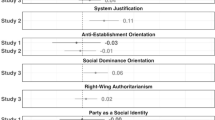Abstract
A 3×2×2 incomplete factorial design was employed to test the effects of sex, dominance, and their interaction on leader emergence. The factors included dominance distribution (high/high, high/low, middle/middle), sex (male-female), and dyad composition (mixed sex-same sex). The subjects were all Caucasians and were pretested on the California Psychological Inventory Dominance Scale. The data revealed that dominance was a predictor of leader emergence in same-sex conditions where high-dominant individuals assumed the role of leader in much greater proportions than their low-dominant partners. In mixed-sex dyads, sex appeared to be a more potent predictor with males becoming leaders at levels greater than would be suspected given dominance levels.
Similar content being viewed by others
References
Aries, E. J., Gold, C., & Weigel, R. H. (1983). Dispositional and situational influence on dominance behavior and small groups. Journal of Personality and Social Psychology, 44, 779–786.
Bartol, K. M. (1973). Male and female leaders of small groups. Bureau of Economic and Business Research. East Lansing: Michigan State University.
Bartol, K. M. (1978). The sex structuring of organizations: A search for possible causes. Academy of Management Review, 805–815.
Bartol, K. M., & Butterfield, D. A. (1976). Effects in evaluating leaders. Journal of Applied Psychology, 61, 446–454.
Bem, S. L. (1975). One consequence of psychological androgyny. Journal of Personality and Social Psychology, 31, 634–643.
Bem, S. L., & Lenny, E. (1976). Sex typing and the avoidance of cross-sex behavior. Journal of Personality and Social Psychology, 33, 48–54.
Bormann, E. G. (1969). Discussion and group methods: theory and practice (2nd ed.). New York: Harper & Row.
Bowman, G. W., Worthy, N. B., & Greyser, S. A. (1965). Are women executive people? Harvard Business Review, 43, 14–17.
Broverman, J. K., Vogel, S. R., Broverman, D. M., Clarkson, F. E., & Rosenkrantz, P. S. (1972). Sex-role stereotypes: A current appraisal. Journal of Social Issues, 28, 50–78.
Cann, A., & Siegfried, W. D., Jr., (1987). Sex stereotypes and the leadership role. Sex Roles, 17, 401–408.
Carbonell, J. L. (1984). Sex roles and leadership revisited. Journal of Applied Psychology, 69, 44–49.
Day, D. R., & Stogdill, R. M. (1972). Leader behavior of male and female supervisors: A comparative study. Personnel Psychology, 25, 353–360.
Doll, P. A. (1965). A comparative study of top level male and female executives in Harris county. Unpublished masters thesis, University of Houston.
Fleischer, R. A., & Chertkoff, J. M. (1986). Effects of dominance and sex on leader selection in dyadic work groups. Journal of Personality and Social Psychology, 50, 94–99.
Gerber, G. L. (1988). Leadership roles and gender stereotype traits. Sex Roles, 18, 649–658.
Gilmer, B. (1961). Industrial psychology. New York: McGraw-Hill.
Goktepe, J. R., & Schneier, C. E. (1989). Role of sex, gender roles, and attraction in predicting emergent leaders. Journal of Applied Psychology, 74, 165–167.
Gough, H. G., (1968). An interpreter's syllabus for the CPI. In P. McReynolds (Ed.), Advances in Psychological Assessment (Vol. 1). Palo Alto, CA: Science and Behavior Books.
Heilbrum, A. B., Jr. (1976). Measurement of masculine and feminine sex role identities as independent dimensions. Journal of Consulting and Clinical Psychology, 44, 183–190.
Martin, C. R., Jr. (1972). Support for women's lib: Management performance. Southern Journal of Business, 7, 19–28.
Megargee, E. I. (1969). Influence of sex roles on the manifestation of leadership. Journal of Applied Psychology, 54, 377–382.
Megargee, E. I., Bogart, P., & Anderson, B. J. (1966). Prediction of leadership in a simulated industrial task. Journal of Applied Psychology, 50, 292–295.
Nyquist, L. V., & Spence, J. T. (1986). Effects of dispositional dominance and sex role expectations on leadership behaviors. Journal of Personality and Social Psychology, 50, 87–93.
Offerman, L. R. (1986). Visibility and evaluation of female and male leaders. Sex Roles, 14, 533–543.
Osborn, R. N., & Vicars, W. M. (1976). Sex stereotypes: An artifact in leader behavior and subordinate satisfaction analysis. Academy of Management Journal, 19, 439–449
Powell, G. N., & Butterfield, D. A. (1979). The “good manager”: Masculine or androgynous? Academy of Management Journal, 22, 395–403.
Schein, V. E. (1973). The relationship between sex role stereotypes and requisite management characteristics. Journal of Applied Psychology, 57, 95–100.
Schein, V. E. (1975). Relationships between sex role stereotypes and requisite management characteristics among female managers. Journal of Applied Psychology, 60, 340–344
Spence, J. T., Helmreich, R., & Stapp, J. (1975). Rating of self and peers on sex role attributes and their relation to self-esteem and conception of masculinity and femininity. Journal of Personality and Social Psychology, 32, 29–39.
Stitt, C., Schmidt, S., & Price, K. (1983). Sex of leader, leader behavior, and subordinate satisfaction. Sex Roles, 9, 31–42.
Author information
Authors and Affiliations
Rights and permissions
About this article
Cite this article
Hegstrom, J.L., Griffith, W.I. Dominance, sex, and leader emergence. Sex Roles 27, 209–220 (1992). https://doi.org/10.1007/BF00289925
Issue Date:
DOI: https://doi.org/10.1007/BF00289925




